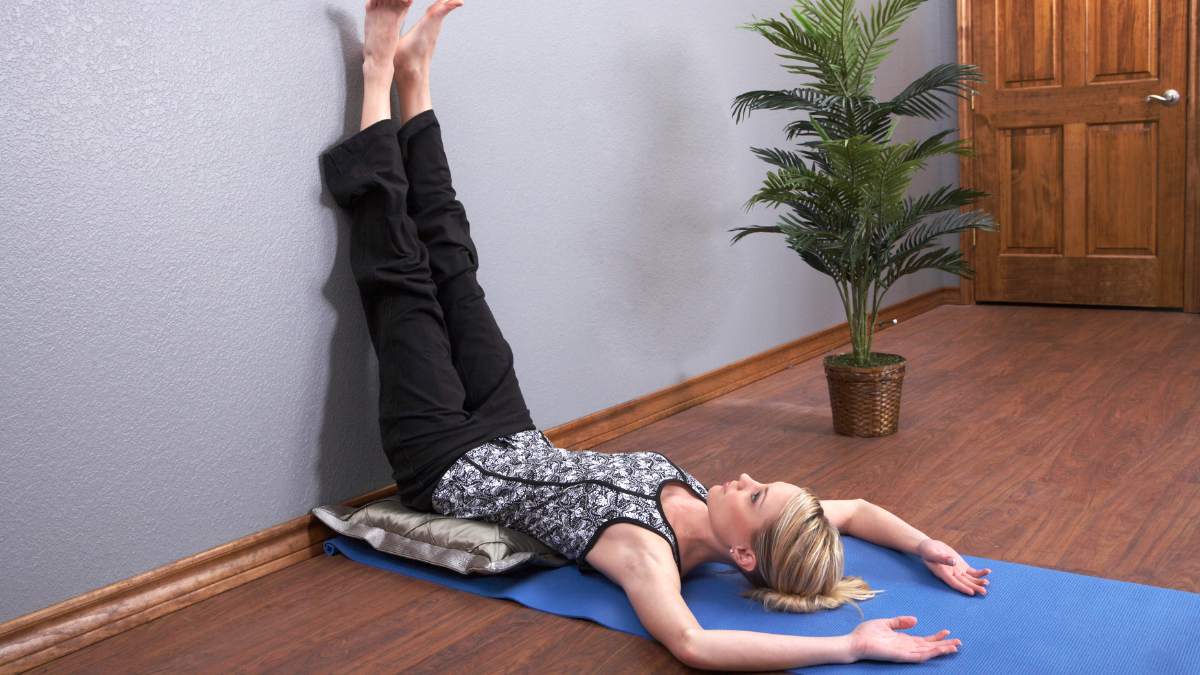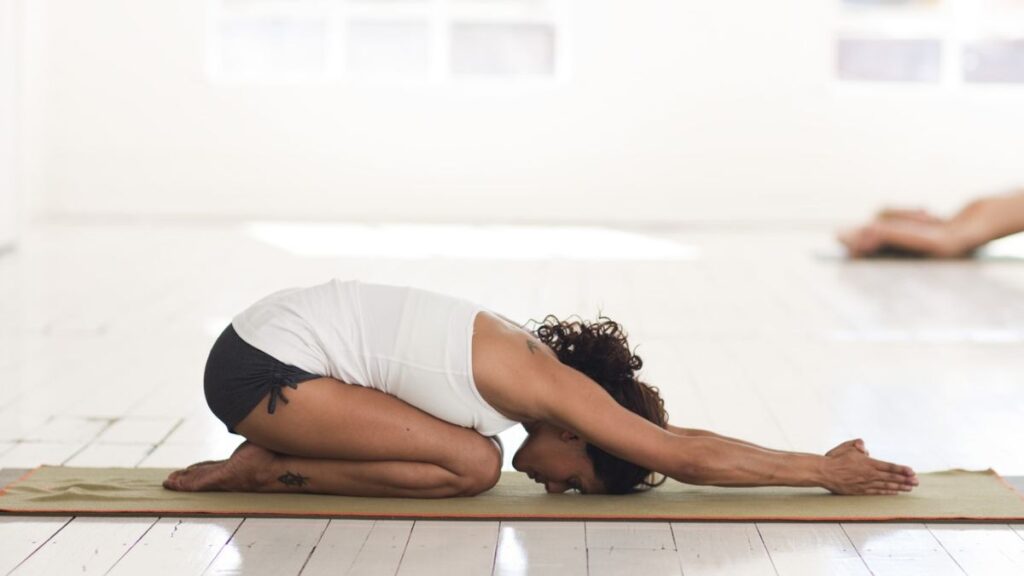Yoga For TMJ Pain – Poses To Ease Jaw Tension!

Last Updated on September 6, 2025
Jaw tightness that never seems to go away? TMJ pain doesn’t just affect your mouth, it can ripple through your entire body.
Eating becomes uncomfortable, headaches creep in, and even sleep feels disrupted when your jaw muscles refuse to relax. It’s not only physical discomfort, but also the frustration of living with constant tension.
So, as a wellness and recovery consultant, I recommend yoga for TMJ pain to my own clients. Gentle postures, mindful breathing, and subtle relaxation practices help release strain in the jaw, neck, and shoulders.
More importantly, yoga teaches the nervous system how to downshift from constant stress, reducing the habits of clenching or grinding. With consistent practice, you can create space for both relief and calm.
| Can Yoga Help With TMJ Pain? Yes, yoga can help relieve TMJ pain by reducing jaw tension, improving posture, and calming stress. Gentle poses and breathing techniques relax tight muscles and support natural jaw alignment. |
Understanding TMJ Pain And Its Trigger

TMJ pain stems from irritation or dysfunction in the temporomandibular joint, the hinge that connects your jawbone to your skull. While dental or structural issues may play a role, lifestyle factors and emotional stress often worsen symptoms.
Recognizing the triggers behind jaw discomfort is the first step toward finding lasting relief.
Common Symptoms of TMJ Pain
The signs often go beyond a sore jaw. Clicking or popping when opening your mouth is common, as is difficulty chewing without discomfort.
Headaches that seem to start at your temples or earaches that mimic sinus pain can also trace back to the jaw joint. Add in neck and shoulder tightness, and it’s easy to see how TMJ affects the whole upper body.
Ever noticed your jaw feels stiff in the morning? Teeth grinding during sleep, also called bruxism, is another hallmark symptom. These signals are your body’s way of flagging tension that needs attention.
Key Triggers That Intensify Discomfort
What makes TMJ pain flare up? Stress is often at the top of the list. When the body stays in fight-or-flight mode, the jaw clenches without conscious control.
Posture plays a role too, hours hunched at a desk or looking down at your phone strain the jaw, neck, and shoulders.
Chewing gum, biting nails, or even chewing mostly on one side can make matters worse. Over time, these habits train the jaw muscles to stay tight, feeding into the cycle of pain.
The good news? Small adjustments and mindful practices can break the loop.
Read Also: Yoga For Frozen Shoulder
How Yoga Supports TMJ Relief

TMJ pain isn’t just a mechanical issue in the jaw, it’s deeply tied to stress, posture, and nervous system balance. That’s why yoga becomes such a powerful tool.
It addresses the root causes of tension instead of only soothing symptoms. Through mindful movement and breath, you create both physical space in the muscles and emotional space in the mind.
The Role of Posture in Jaw Health
Posture is one of the most overlooked pieces of the TMJ puzzle. When the head juts forward or shoulders round in, the jaw joint has to compensate. This extra pressure often leads to more pain and stiffness. Studies show this correlation between TMDs (Temporomandibular Disorders) and posture.
Yoga helps restore alignment by strengthening the upper back and lengthening tight chest muscles. A steady practice encourages the head, neck, and jaw to return to their natural relationship. Better posture doesn’t just feel good, it literally takes the weight off your jaw.
Stress Reduction Through Mindful Movement
Jaw clenching rarely happens in isolation, it’s often stress-driven. When your nervous system stays in high alert, the jaw responds with tension. Yoga works by gently shifting the body from “fight or flight” into a calmer state.
Restorative yoga poses and breathwork lower stress hormones, signaling to the muscles that it’s safe to release. Think of yoga as teaching your jaw to let go of its grip. The more consistently you practice, the more your body remembers how to soften instead of tighten.
Read Also: Yoga For Knee Pain
Gentle Yoga Poses For TMJ Pain Relief
When practicing yoga for jaw discomfort, the goal isn’t intensity, it’s release. Gentle, supported poses allow the nervous system to calm while giving the jaw, neck, and shoulders a chance to unwind.
Here are a few restorative options to begin with.
Supported Child’s Pose (Balasana)
This pose helps you drop tension from the upper body while creating a sense of safety and rest. Place a bolster or pillow under your chest for comfort. Rest your forehead down and let your jaw soften, keeping the lips closed but teeth slightly apart.
Slow breaths into the belly amplify the effect. With each exhale, imagine your jaw melting into the floor. Five minutes here can feel like a reset button for both body and mind.
Seated Neck Stretch with Jaw Relaxation
Neck stiffness and jaw tension go hand in hand. From a comfortable seat, gently tilt one ear toward your shoulder and let the opposite side lengthen. While holding the stretch, unclench your jaw by softly separating the teeth.
Want a quick check? Place the tip of your tongue on the roof of your mouth, just behind the front teeth, this keeps the jaw naturally relaxed. Switch sides and notice how your entire face feels lighter.
Reclined Bound Angle Pose (Supta Baddha Konasana)
Lying back with the soles of your feet together and knees open, place a cushion under each knee for support. Rest your hands on your belly and invite your jaw to soften. This pose encourages total-body release, especially when paired with slow, steady breathing.
Adding a brief jaw relaxation exercise, like gently massaging the masseter muscles just in front of the ears, can make this pose even more effective.
Legs-Up-the-Wall Pose (Viparita Karani)
One of the simplest but most powerful restorative shapes, this pose soothes the nervous system and eases tension held in the jaw at night. Lie on your back with legs extended up a wall, supporting the hips with a folded blanket if needed.
Close your eyes, relax your jaw, and let the weight of the day drain away. This is especially helpful before bed if nighttime clenching or teeth grinding are a problem.
Read Also: Yoga Poses To Improve Posture
Breathing And Relaxation Practices For Jaw Release

Breathwork is one of the most underrated tools for TMJ relief. The way you breathe directly impacts the way your muscles respond to stress.
When the breath is shallow and quick, the nervous system stays in overdrive, fueling clenching. Slowing down and deepening the breath sends the opposite message: it’s safe to relax.
Diaphragmatic Breathing
This simple technique shifts the body from tension to calm in minutes. Place one hand on your belly, inhale through the nose, and let your abdomen rise. As you exhale, consciously release your jaw by keeping the teeth apart.
Think of each exhale as a chance to drop what your jaw has been holding. Practicing for five minutes a day can dramatically lower overall tension.
Alternate Nostril Breathing (Nadi Shodhana)
Balancing both sides of the nervous system makes a real difference in jaw relaxation. Using your thumb and ring finger, gently close one nostril at a time, inhaling and exhaling through alternating sides.
This technique not only clears mental fog but also helps soften facial muscles. By evening out your body’s stress response, it creates conditions where the jaw doesn’t need to clamp down.
Guided Jaw Release Visualization
Visualization can be surprisingly powerful when paired with yoga. As you sit or recline comfortably, picture warmth and softness spreading across the jaw, cheeks, and temples with each breath.
Imagine the muscles unclenching like a flower opening. This mental practice conditions your body to recognize tension and let go. It’s especially helpful before sleep or after a stressful day.
Read Also: Best Yoga Poses For Beginners At Home
Mindful Habits To Support TMJ Relief
Relieving jaw pain isn’t just about what happens on the yoga mat, it’s about what you do throughout your day. Tiny habits add up, and small adjustments can stop the cycle of clenching before it begins. Think of it as weaving mindfulness into your daily routine.
Simple Supportive Habits for Daily Ease
- Keep lips closed, teeth apart: This resting position takes pressure off the joint.
- Massage jaw muscles gently: Use fingertips to release knots around the temples and jawline.
- Limit gum chewing: Overuse of jaw muscles can make pain worse.
- Practice “jaw check-ins”: Pause during work or driving to notice and release hidden clenching.
Ever notice tension sneaks in during emails, driving, or even watching TV? These check-ins make you aware of subtle habits that build pain. Over time, these mindful shifts pair perfectly with yoga to keep your jaw calmer day to day.
When To Seek Professional Care
Yoga offers real relief for jaw discomfort, but there are times when professional care is essential. Knowing when to reach out ensures that you don’t ignore deeper issues. TMJ disorder varies in severity, and while gentle practices help, some cases need medical evaluation.
If your jaw locks, makes loud clicking sounds, or feels painful with every bite, it’s wise to consult a dentist or healthcare provider. Severe ear pain, or limited jaw movement are also signals to seek care. These symptoms may indicate structural concerns that require more than self-care.
Think of yoga as a supportive partner to treatment, not a replacement. Many people find the best results when combining mindful practices with physical therapy, dental appliances, or medical guidance. This integrative approach supports healing from both the physical and emotional angles.
Final Thoughts
Living with TMJ pain can feel exhausting, but relief is possible with small, intentional changes. Gentle yoga practices, paired with mindful breathing and supportive habits, help soften the grip of tension while calming your nervous system.
You don’t need to overhaul your entire routine to see progress. Even five minutes of restorative poses or a few mindful jaw check-ins each day can make a noticeable difference. With consistency, your body learns to let go of unnecessary strain and rest in greater ease.
Remember, healing isn’t about perfection, it’s about support. When you approach your practice with patience and compassion, you give your jaw, mind, and body the space they’ve been waiting for.
Sources
- Giuseppe Minervini, et al. (2023). Correlation between Temporomandibular Disorders (TMD) and Posture Evaluated trough the Diagnostic Criteria for Temporomandibular Disorders (DC/TMD): A Systematic Review with Meta-Analysis






